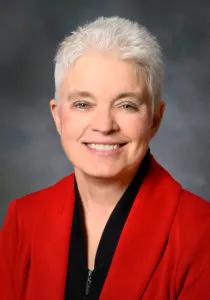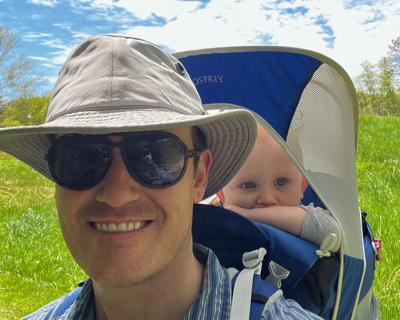
George E. Tesar, MD (IM’80), who recently retired after 31 years at Cleveland Clinic, received awards throughout his career. These include Cleveland Clinic’s Bruce Hubbard Stewart Award; Distinguished Life Fellow, American Psychiatric Association; recurring recognition as one of the Best Doctors in America; Exemplary Psychiatrist Award by the National Alliance for the Mentally Ill; and, twice, Teacher of the Year by Cleveland Clinic’s Psychiatry residents. Still, he was surprised when chosen for the Alumni Association’s Distinguished Alumnus Award.
Advertisement
Cleveland Clinic is a non-profit academic medical center. Advertising on our site helps support our mission. We do not endorse non-Cleveland Clinic products or services. Policy
“Honestly, I was shocked,” he says, “I just thought, ‘There must not have been any other nominees.’”
Such self-effacing humor and humility are among the qualities his colleagues lauded in nominating him.
“I must say, I will always remember Dr. Tesar for his wit,” said Karen Jacobs, DO (P’92). “He is a natural at intertwining comic relief into the most serious of topics. At graduation ceremonies, he personally created humorous slides and narratives about each graduate. Knowing Dr.Tesar, he spent countless hours making these slides ‘just right.’ After he stepped down, we changed the graduation format where graduates could ask a particularly close mentor of theirs to speak on their behalf. Residents clamored to request his speaking for them.” His serious side also was praised. “George is a dedicated and outstanding clinician,” said Lillian Gonsalves, MD, FAPM, FACP (P’81), Interim Chair of the Department of Psychiatry and Psychology. “He leads by example and often is the first one in and last one out in the department. He sees volumes of difficult patients from all walks of life, keeping them functioning at their best.”
Following residency training and board certification in internal medicine at Cleveland Clinic from 1977 to 1980, Dr. Tesar pursued psychiatry, a field that had interested him since his days as a Yale University undergraduate majoring in philosophy and psychology.
“It took me a while to make up my mind,” he says. “Supervisors and colleagues seemed to raise an eyebrow anytime I mentioned the psychiatry thing and ask, ‘Why would you do that?’ Board certification in internal medicine gave me the credibility and self-assurance that I was, indeed, a ‘real’ doctor first, and a future psychiatrist second.”After completing a second residency and fellowship training in psychiatry at Massachusetts General Hospital, he served there as Director of Emergency Psychiatry before returning to Cleveland Clinic as Chair of the Department of Psychiatry and Psychology from 1993 to 2009. From 1997 to 2009, he also served as Medical Director for Marymount Behavioral Healthcare Services and Cleveland Clinic Health System Behavioral Medicine Services.
Advertisement
In 2009, Dr. Tesar was appointed Director of General Adult Psychiatry Residency Training, a position he held through 2015. From 2007 until retiring July 1, 2021, he also was psychiatric consultant to the Cleveland Clinic Epilepsy Center.
A graduate of Mayo Medical School in Rochester, Minnesota, Dr. Tesar says he feels lucky to have had the finest supervision and mentorship throughout his training. Although transitioning from Department Chair to Program Director reversed the usual career path, he says, it was an exciting opportunity to strengthen medical student, residency and fellowship training in psychiatry at Cleveland Clinic. He also enjoyed passing on the lessons he learned from his own mentors and role models at Mayo Clinic, Cleveland Clinic and Massachusetts General Hospital.
“Cleveland Clinic has played a major role in the evolution of my career, and I’ve always been struck by how good an environment we had with regard to the relationship between our service and other medical services,” Dr. Tesar says, “While the Department of Psychiatry was often derided as ‘the necessary evil’ from a financial perspective, we have always been viewed by our medical/surgical colleagues as valued members of the team.”
Dr. Tesar says his mentors and role models as an internal medicine resident at Cleveland Clinic included his chief resident, Len Calabrese, DO (IM’78, RH’80), Herschel Gorn, MD (Staff’70), Martin McHenry, MD (Staff’72), A. Dale Gulledge, MD (Staff’77), and Richard M. Steinhilber, MD (Staff’77).
Advertisement
He regards legitimizing the role of psychiatry in the general hospital setting as one of his greatest accomplishments. “Mental health comes along with stigma and controversy,” he says. “At my first staff meeting, CEO and President Fred Loop MD (TS’70), introduced me with tongue-in-cheek as the new Chair of Psychiatry, ‘thankfully a ‘normal’ psychiatrist.’ We helped establish the legitimacy of the clinician behaviorist, and I was lucky to have a remarkable group of clinicians who shared my views.”

Special Achievement Award recipient Melinda “Mindy” Estes, MD, MBA (NPTH’84), is a board-certified neurologist and neuropathologist who started her career at Cleveland Clinic in 1982 and rapidly rose through the ranks.
In 1990, at the age of 38, Dr. Estes became the first woman ever appointed to Cleveland Clinic’s Board of Governors. When Crain’s Cleveland Business included her in its list of “Forty Under 40,” it noted that “for someone who initially planned a career in music while attending Sam Houston State University in Huntsville, Texas,” Dr. Estes “had garnered a list of achievements uncommon to most doctors her age.” This included becoming Associate Chief of Staff the year before, the youngest woman to help lead Cleveland Clinic’s then-500-plus physicians.
Since that time, Dr. Estes has served as CEO and Chair of the Board of Governors of Cleveland Clinic Florida; Executive Director of Business Development at Cleveland Clinic; Chief Medical Officer at Cleveland Clinic Florida; Executive Vice President and Chief of Staff for the MetroHealth System in Cleveland; President and CEO of the Burlington, Vermont-based Fletcher Allen Health Care; and, from 2011 to the present, President and CEO of the Saint Luke’s Health System in Kansas City, Missouri.
Advertisement
Even with all of these accomplishments, Dr. Estes says she was surprised to learn she was selected for the 2020 Special Achievement Award.
“I found myself reflecting on when I first arrived at Cleveland Clinic for my neuropathology fellowship,” she says. “My husband [Harold Morris, MD (Staff’82)], an epileptologist, had joined Dr. Hans Luder (Staff’78) and his team. I was fortunate to become a fellow and spend the first part of my career doing research with Dr. Carlos Ferrario (Staff’66) and Dr. Karen Barnes (Staff’76). I remember having conversations in the Doctors Dining Room about how frontline workers should get involved in the business and administrative sides of medicine. Cleveland Clinic was groundbreaking in having administrative physicians. I was fortunate to become Associate Chief of Staff to Dr. Ralph Straffon (Staff’59), and to be sent back to school at Case Western Reserve University for my MBA. I am grateful for all those opportunities.”
Dr. Estes says that she believes it is especially important for physicians to have progressive administrative responsibility. “You can’t go from practicing physician one day to CEO the next. I had the opportunity to chair a number of committees and learn the ins and outs of what makes a multispecialty physicians group work and succeed, including how it interfaces with the community.”
She also values her training in Cleveland Clinic’s Division of Laboratory Medicine and counts among her physician mentors Dr. Straffon, Dr. George Hoffman (CLPTH’59), Dr. Sam Chou (Staff’81), Dr. Joe Hahn (Staff’76), and Rob Coulton. Administrator of the Office of Professional Staff Affairs. “It was a great environment to work in,” she says.
Advertisement
Even with all of her administrative positions, Dr. Estes continued to practice medicine. “That’s one of the hallmarks of physician leadership,” she says. “Everyone at Cleveland Clinic practiced medicine, from Dr. [Fred] Loop (TS’70) to others in the organization. This allows you to always remember why we do what we do, to provide the best patient care we possibly can. It helps to remember this in your administrative career in order to impact change, change processes and connect with your colleagues on the front lines.”
Patient care is the common thread among the various positions she has had and health systems in which she has worked, she says. “This is also at the very core of what makes Cleveland Clinic a world-renowned organization, a guide star for successful healthcare organizations.”
She advises her fellow alumni to “engage fully and take advantage of the opportunities that come your way. A career is not a straight line, and you don’t want to come to the end of it and say, ‘I wish I’d taken that risk.’ There is no perfect time. I also would suggest actively listening to all levels of your organization, particularly to those on the front lines, and never be afraid to change your mind if the data or information sends you in a different direction. That’s actually a sign of strength.”

Susan Rehm, MD (IM’81, ID’83), says she is “honored and humbled” to receive the Service Award from Cleveland Clinic’s Alumni Association, which she led as Board President from 2014 to 2016. She also served as the Alumni Association’s Infectious Disease Specialty Director from 2008 to 2017; President-Elect from 2012 to 2014; and Immediate Past-President from 2016 to 2018.
“It is such a privilege to remain connected to Cleveland Clinic staff and trainees through our Alumni Association,” Dr. Rehm says. “One of the reasons I trained and stayed at the Clinic is the opportunity to work with incredible teams from a variety of disciplines. While we all identify with an individual specialty, the impact is exponentially amplified when we collaborate and grow together. The Cleveland Clinic Alumni Association exemplifies that spirit. Through it, we expand the personal and professional connections that are the essence of the Cleveland Clinic.”
A member of Cleveland Clinic’s Endocarditis Team, Dr. Rehm says she derives great satisfaction from her work, both professionally and personally. “My infectious disease partners and I work with exceptionally talented members of cardiac surgery, cardiology, anatomic pathology, microbiology, critical care, neurology, nephrology and pharmacy departments, to name just a few,” she says. “Interprofessional teams within each department work together to form a multidisciplinary ‘team of teams,’ providing specialized care to these patients with extremely complex cardiovascular infections. It represents Cleveland Clinic at its best.”
Dr. Rehm especially values medical education, and she has been Program Director for both the Infectious Disease (ID) Fellowship and its Internal Medicine Residency Program.
“It is so gratifying to witness the accomplishments of our alumni in their diverse careers,” she says. “‘Educating those who serve’ is at the core of Cleveland Clinic’s mission, and it is our bridge to the future. So many Cleveland Clinic trainees comment about the excellence of their residency and fellowship programs. One of the more frequent observations is, ‘I didn’t know how great it was until I left!’ Many refer to our culture of teamwork.”
She values her own Cleveland Clinic training, as well. “Though we worked hard, we saw fascinating patients and learned from dedicated clinicians who were leaders in their fields.” She counts among her mentors Phil Hall, (IM’68, H/N’69), who was her Internal Medicine Program Director, and Marty McHenry (Staff’67), then Chair of Infectious Disease and ID Fellowship Program Director.
“They were mentors and role models for the personal and professional excellence I still try to achieve,” she says. “My wise internal medicine continuity clinic mentors, Tom Gruen (IM’69, H/O’70) and Bill Shafer (Staff’59), provided lessons in professionalism that have lasted a lifetime. And what a treat to work with Mehdi Razavi (CARD’67) during my cardiology rotation! Though I was a lowly intern, he took me along to review cardiac cath films with Fred Loop (TS’70) and Toby Cosgrove (TS’75), and to discuss cases with Mason Sones (Staff’50). I am so grateful to mentors who helped me as a member of the Cleveland Clinic staff – people like Gita Gidwani (Staff’76), Vic Fazio (S’73, CRS’74), Edgar Achkar (GE’69) and Ralph Straffon (Staff’59). Mentorship by a variety of great clinicians and scientists is an integral part of the culture of Cleveland Clinic.”
Dr. Rehm continues to stay connected with her colleagues through the Alumni Association. “The Alumni Association perpetuates the spirit of collaboration through sponsoring reunion gatherings and the Cleveland Clinic Alumni Connect app,” she says. “I would like to thank the Alumni Association for its support of our 22,000-plus trainees and staff. Their investment in current and future alumni perpetuates Cleveland Clinic’s culture of excellence.”
In early 2003, Richard Drake, PhD, (Staff’03), recently retired Director of Anatomy at the Cleveland Clinic Lerner College of Medicine, was drawn to the new medical school’s unusual approach to education, including an interactive format without lectures and with competency-based student evaluations.

“As I began to gather information related to the planning/development of this unique medical school, I interacted with Dr. Andy Fishleder (LMED’82, CLPTH’91), and Dr. Jeff Ponsky (Staff’14),” he says. “I was very impressed with these individuals and their forward-thinking approach to the education of medical students. Even though I had been teaching medical students for 26 years and was a tenured professor and Vice Chair of the Department of Anatomy and Cell Biology at the University of Cincinnati College of Medicine, it was through these conversations that I was convinced that the Cleveland Clinic Lerner College of Medicine was going to be the next stop in my academic career.”
Dr. Drake, who is being honored with a 2021 Alumni Association Service Award, has written and published a variety of anatomy textbooks. “They provide students at all levels of training with the basic information they need to move forward in their professional careers,” he says. The books also led to his receiving the prestigious Dr. Jose Eleuterio Gonzalez medal for outstanding contributions to medical education from the Universidad Autonoma De Neuevo Leon in Monterrey, Mexico, in 2019. They include:
* Gray’s Anatomy for Students Flash Cards (4th edition), a valuable learning aid for students hoping to enhance their understanding of human anatomy
* Gray’s Basic Anatomy (2nd edition, 3rd edition to be published in April 2022), a shorter/more concise textbook of anatomy
* Gray’s Atlas of Anatomy (3rd edition), with artistic renderings of internal anatomy, as well as surface anatomy and anatomy as seen using modern imaging techniques
*Gray’s Surface Anatomy and Ultrasound (1st edition), a resource blending surface anatomy with ultrasound
“Gray’s Anatomy for Students was conceived when the publisher began conversations in 1999 with me and my co-author Wayne Vogl, a faculty member at the University of British Columbia in Vancouver, Canada,” Dr. Drake says. “At that time, there was primarily one anatomy text that was used around the world. It was published in 1980, and we felt we could develop a new anatomy textbook that would better meet the needs of current medical students. We added a third author, a physician in London, England, who would be responsible for clinical content, and started to write. Several illustrators submitted samples of their work, and we chose two individuals who worked together in London. With the team together, the project moved forward. The first edition was published in 2005, with the first class of medical students at the Lerner College of Medicine using preprints of the book in the fall of 2004.”
This text, now in its fourth edition, has been published in 14 languages and is widely used at medical schools around the world. Dr. Drake and his coauthors are working on the fifth edition, to be published in April 2023.
Dr. Drake says it is an honor both to receive the Alumni Service Award and to have taught at the Lerner College of Medicine. “I am very excited and humbled to be recognized in this way by the Cleveland Clinic Alumni Association. And it has been a distinct privilege and great opportunity to have been able to work with the intelligent and highly motivated students at CCLCM.”
Advertisement

We celebrate the exceptional achievements of four future alumni

Honoring Exceptional Achievement and Leadership

Meet Hardeep Phull, MD (CCLCM’11)

Meet William Tierney, MD, MS (CCLCM’16, OTO’18)

Meet Samuel Omotoye, MD (CARD/E'15)